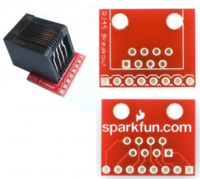Riker1 - for the renogy connector pinout see post #11.
I had to connect the 0V too, without the comms is unreliable. To keep the renogy cable in one piece, I used one of these;

Also worth noting; I tried to use the renogy 5V (pin 1) to power my arduino/OLED, 200mA is easily enough for this BUT, it seems that the MAX485 output burst cripples it. Every 2 second (my poll rate) the 5V dips and the OLED dims. I have read that the 120ohm terminators can be increased, or even omitted in some circumstances, but my quick fix was to power the whole thing from 12V and a buck converter.
I had to connect the 0V too, without the comms is unreliable. To keep the renogy cable in one piece, I used one of these;

Also worth noting; I tried to use the renogy 5V (pin 1) to power my arduino/OLED, 200mA is easily enough for this BUT, it seems that the MAX485 output burst cripples it. Every 2 second (my poll rate) the 5V dips and the OLED dims. I have read that the 120ohm terminators can be increased, or even omitted in some circumstances, but my quick fix was to power the whole thing from 12V and a buck converter.

